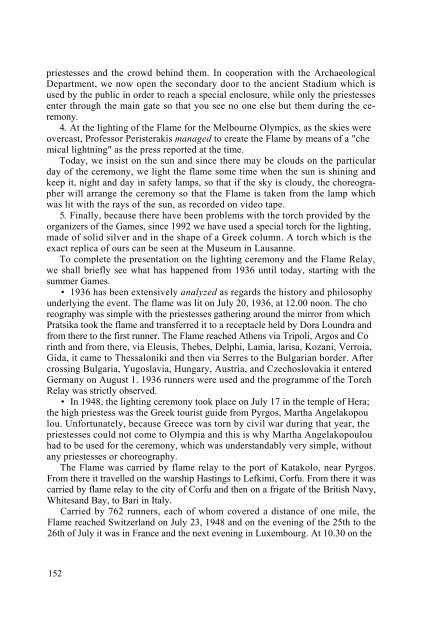Create successful ePaper yourself
Turn your PDF publications into a flip-book with our unique Google optimized e-Paper software.
priestesses and the crowd behind them. In cooperation with the Archaeological<br />
Department, we now open the secondary door to the ancient Stadium which is<br />
used by the public in order to reach a special enclosure, while only the priestesses<br />
enter through the main gate so that you see no one else but them during the ceremony.<br />
4. At the lighting of the Flame for the Melbourne Olympics, as the skies were<br />
overcast, Professor Peristerakis managed to create the Flame by means of a "che<br />
mical lightning" as the press reported at the time.<br />
Today, we insist on the sun and since there may be clouds on the particular<br />
day of the ceremony, we light the flame some time when the sun is shining and<br />
keep it, night and day in safety lamps, so that if the sky is cloudy, the choreographer<br />
will arrange the ceremony so that the Flame is taken from the lamp which<br />
was lit with the rays of the sun, as recorded on video tape.<br />
5. Finally, because there have been problems with the torch provided by the<br />
organizers of the Games, since 1992 we have used a special torch for the lighting,<br />
made of solid silver and in the shape of a Greek column. A torch which is the<br />
exact replica of ours can be seen at the Museum in Lausanne.<br />
To complete the presentation on the lighting ceremony and the Flame Relay,<br />
we shall briefly see what has happened from 1936 until today, starting with the<br />
summer Games.<br />
• 1936 has been extensively analyzed as regards the history and philosophy<br />
underlying the event. The flame was lit on July 20, 1936, at 12.00 noon. The cho<br />
reography was simple with the priestesses gathering around the mirror from which<br />
Pratsika took the flame and transferred it to a receptacle held by Dora Loundra and<br />
from there to the first runner. The Flame reached Athens via Tripoli, Argos and Co<br />
rinth and from there, via Eleusis, Thebes, Delphi, Lamia, larisa, Kozani, Verroia,<br />
Gida, it came to Thessaloniki and then via Serres to the Bulgarian border. After<br />
crossing Bulgaria, Yugoslavia, Hungary, Austria, and Czechoslovakia it entered<br />
Germany on August 1. 1936 runners were used and the programme of the Torch<br />
Relay was strictly observed.<br />
• In 1948, the lighting ceremony took place on July 17 in the temple of Hera;<br />
the high priestess was the Greek tourist guide from Pyrgos, Martha Angelakopou<br />
lou. Unfortunately, because Greece was torn by civil war during that year, the<br />
priestesses could not come to Olympia and this is why Martha Angelakopoulou<br />
had to be used for the ceremony, which was understandably very simple, without<br />
any priestesses or choreography.<br />
The Flame was carried by flame relay to the port of Katakolo, near Pyrgos.<br />
From there it travelled on the warship Hastings to Lefkimi, Corfu. From there it was<br />
carried by flame relay to the city of Corfu and then on a frigate of the British Navy,<br />
Whitesand Bay, to Bari in Italy.<br />
Carried by 762 runners, each of whom covered a distance of one mile, the<br />
Flame reached Switzerland on July 23, 1948 and on the evening of the 25th to the<br />
26th of July it was in France and the next evening in Luxembourg. At 10.30 on the<br />
152

















